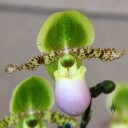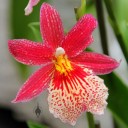Office Orchids
Orchids have been staples of office decor since supermarkets and garden centers began selling mass-produced plants in the 1980’s. Tough, modern hybrids can survive, and even thrive, in work environments which often have less than ideal growing conditions. Check the following tips to keep your office orchid blooming:
- As always, it helps to know what kind of orchid you have. Phals (like the first picture below) are the most common type. Other varieties have different light, water, and temperature needs. If you can’t identify your orchid, use these basic care tips.
- Maintaining good humidity is one of the biggest challenges for office orchids. Heaters and air conditioners can dry the air to desert-like levels. Keep orchids out of the direct path of heat or air vents. Group plants together. Place orchids on trays of pebbles and water, keeping the pots above the water level. Spray regularly with purified water or rainwater. Watch for pests which thrive in dry air, like spider mites, mealybug, and scale.
- Low light can hinder office orchids from blooming. Natural light through a window, with supplemental light in winter, will make your plant feel like it’s living in the tropics. Close distance to the light source is important: light levels drop significantly just 1 foot (30 cm) from a window or bulb. Ceiling lights may be fine for human eyes, but are too far away to provide energy for photosynthesis. If you add artificial light, keep leaves 6 – 12 inches (15 – 30 cm) from bulbs, but not so close that leaves burn. Install a timer to turn on the light over weekends and holidays. Take advantage of white walls and other reflective surfaces to increase brightness.
- Assuming you can’t control temperatures in your office, work with what you have. Remember that there are many great orchid choices, including lots of cool growers. Even the tiniest cubicle has a few different microclimates. Since heat rises, a high shelf can suit a warm grower, while a desk provides a home for an intermediate grower, and space on a floor harbors a cool grower.
- Fertilizing weakly, weekly works best. Use ¼ – ½ the dose recommended on the label. Fertilize less often during winter dormancy.
- Find reliable coworkers to babysit over vacations or sick days. Make sure they know to water enough to run out of the holes in the bottom of pot, and never to let the plant sit in water for any extended period. And don’t forget to tell them they can find answers to their orchid questions at AboutOrchids.com.
Explore posts in the same categories: Dormancy, Fertilizing, Growing, Photos, Problems, Watering
Subscribe to the About Orchids Blog:
![]()






July 23rd, 2012 at 5:08 pm
This is so helpful! I’ll send this link to all my fellow orchid growers in my office.
July 27th, 2012 at 6:03 pm
Hi! Your article rocks as well as being a legitimate wonderful. Couldn’t be easier to understand! This is very useful orchid advice.
July 31st, 2012 at 7:13 am
very helpful
August 8th, 2012 at 5:05 pm
Good ! My office orchids help me get through each day. They have not flowered in several years. I understand why from being too far from the window. I hope that helps them flowre again. I should certainly pronounce, impressed with your website. I had no trouble navigating through all the tabs as well as related information ended up being truly simple to do to access.
August 12th, 2012 at 9:33 pm
An outstanding share! I’ve just forwarded this onto a colleague who had been doing a little research on orchids. And he actually bought me lunch simply because I stumbled upon it for him… lol. So allow me to reword this…. Thanks for the meal!! But yeah, thanks for spending time to talk about this subject here on your site.
August 20th, 2012 at 12:03 am
Flowers provide a cheerful light to the workplace, when also permitting somebody
know that you are proud of his or her achievements.
While spring can take along many vibrant flowers, there
are some flowers especially that incorporate much more pleasure to the season.
Moth orchids and ladyslippers are easy to grow.
September 3rd, 2012 at 8:19 am
It s actually a great and useful piece of info. I am glad that you simply shared this helpful information with us. Please stay us up to date like this. Thank you for sharing.
September 12th, 2012 at 1:21 am
I do trust all the ideas you’ve introduced in your post. They’re really convincing and will definitely work.
Nonetheless, the posts are very brief for beginners.
Could you please prolong them a bit from next time? Thank you for the post.
November 4th, 2012 at 3:47 pm
Thanks for any other wonderful post. Where else may anyone get that kind of info in such an ideal approach of writing?